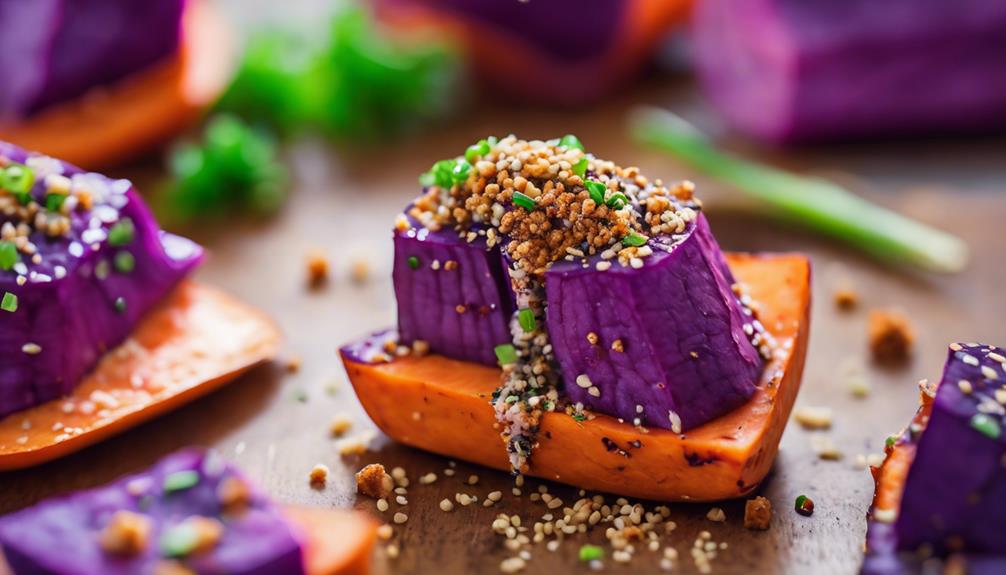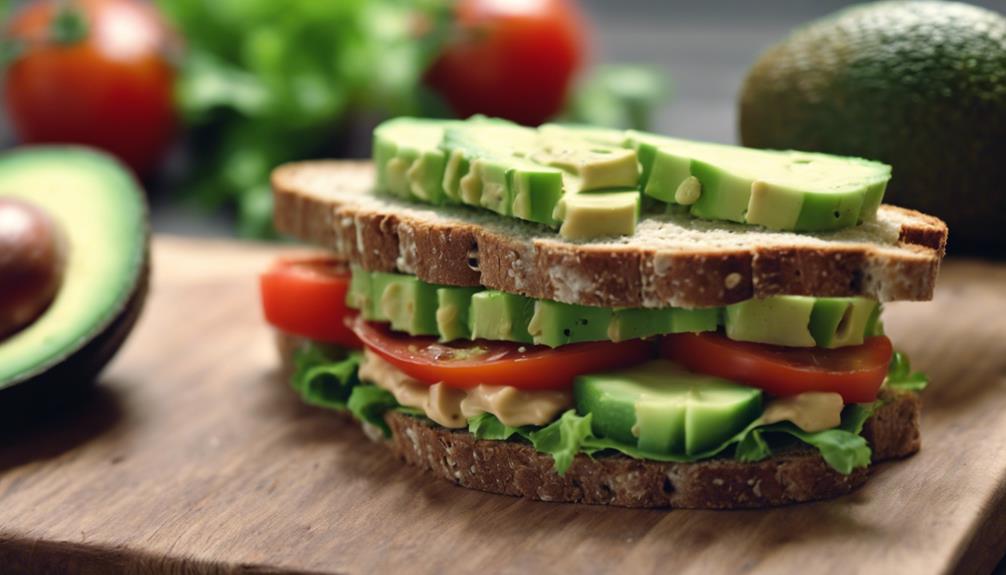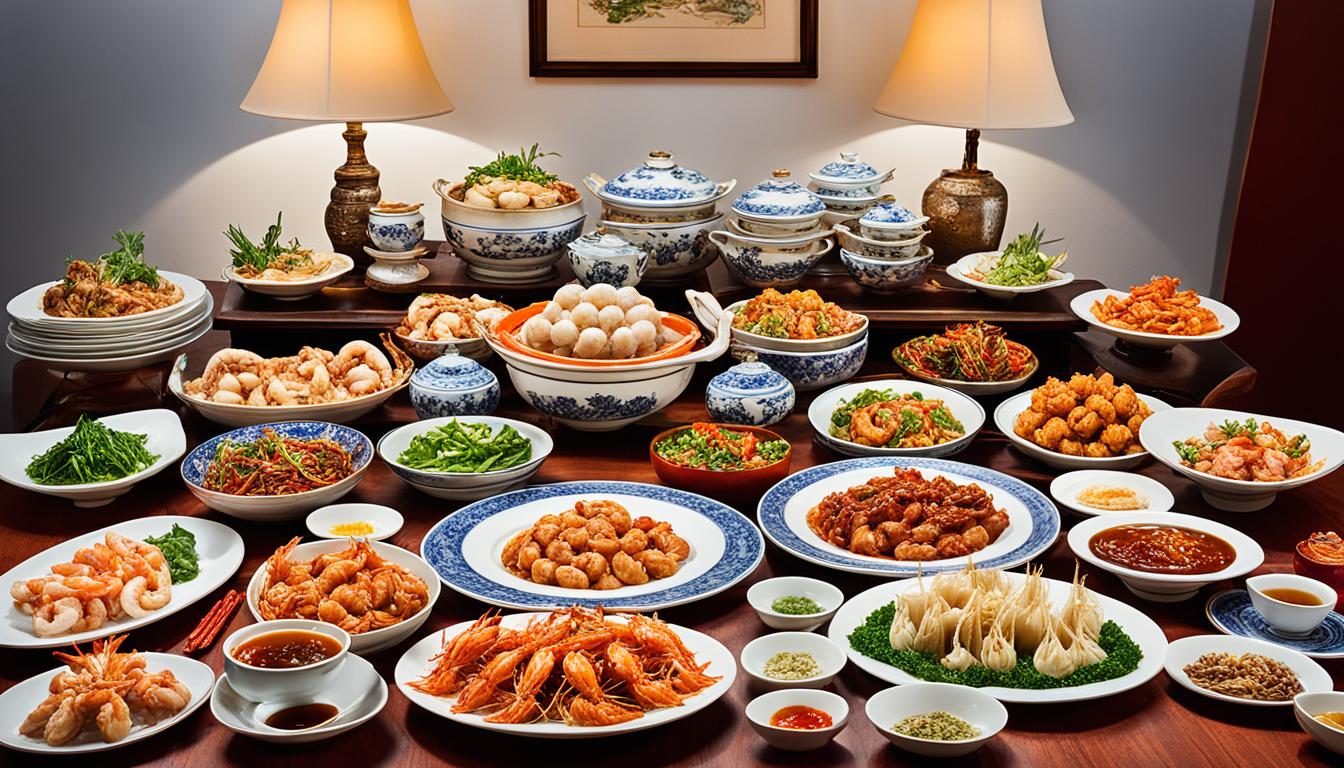Umami, known as the fifth basic taste, adds a rich, savory flavor to your meals. This pleasant taste comes from the amino acid glutamate, found in foods like aged cheeses, cured meats, mushrooms, and tomatoes. Discovered in 1908, umami enhances overall flavor experiences and even stimulates your appetite. It's commonly used in cooking through seasonings like soy sauce and MSG, both of which amplify savory notes without excessive salt. Incorporating umami into your dishes can transform simple recipes into extraordinary culinary delights. Keep exploring, and you'll reveal the secrets of this fascinating taste!
Key Takeaways
- Umami, a savory taste, enhances flavor, primarily derived from the amino acid glutamate found in foods like aged cheeses and cured meats.
- Discovered in 1908, umami is scientifically recognized and has flavor receptors identified on the tongue since 2002.
- Common sources of umami include fermented products such as soy sauce, miso, and natural foods like mushrooms and seafood.
- Monosodium glutamate (MSG) is a popular flavor enhancer derived from glutamate, considered safe for consumption and often used in Asian cuisine.
- Incorporating umami-rich ingredients can increase satisfaction and promote fullness while reducing the need for excess sodium in dishes.
Definition of Umami
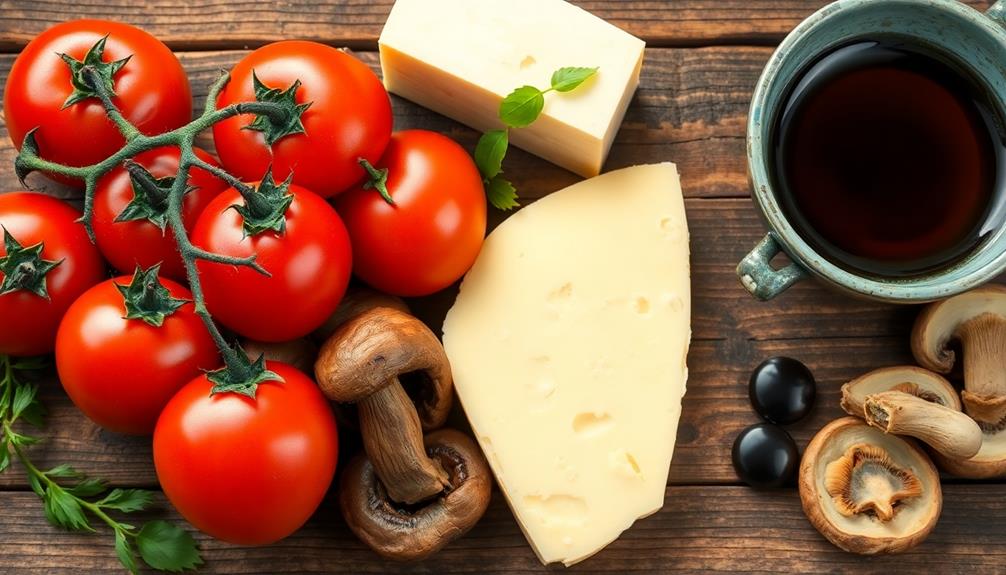
Umami stands out as one of the five basic tastes, bringing a pleasant savory flavor to your palate. This taste, which translates to "pleasant savory taste" in Japanese, is primarily linked to the amino acid glutamate. Discovered in 1908, umami has gained recognition for its ability to elevate the overall flavor experience of various dishes, much like the rich and savory notes found in traditional dishes such as Red-Braised Pork Belly.
When you savor umami-rich foods, specific receptors on your tongue activate, signaling a sense of deliciousness. You might find this taste in protein-rich options like aged cheeses, cured meats, mushrooms, tomatoes, and seafood. Each of these foods contributes to umami's distinctive savory flavor, enhancing your meal and making it more satisfying.
Umami isn't just about taste; it plays a vital role in stimulating your appetite and preparing your digestive system for food. By incorporating umami-rich ingredients into your cooking, you can create dishes that not only taste better but also encourage a more enjoyable eating experience.
Understanding umami helps you appreciate the depth of flavor it brings, transforming ordinary meals into delightful culinary adventures.
Historical Discovery

In the early 20th century, a groundbreaking discovery changed how we comprehend taste. The Japanese scientist Kikunae Ikeda coined the term "umami" in 1908 after isolating glutamate from kombu seaweed broth. He identified this compound as the source of a unique taste that had been largely overlooked.
Ikeda's findings led to the creation of monosodium glutamate (MSG), initially derived from seaweed and later produced through fermentation. Despite his pivotal work, umami didn't gain recognition as a primary taste in Western culinary science until 1985. The scientific community truly validated Ikeda's contributions when umami taste receptors were discovered on the human tongue in 2002.
To illustrate the significance of umami, consider the following table:
| Year | Discovery/Event | Significance |
|---|---|---|
| 1908 | Ikeda coins "umami" | Identifies a new taste |
| 1985 | Umami recognized in the West | Validates Ikeda's findings |
| 2002 | Taste receptors discovered | Establishes umami as a basic taste |
Historically, various cultures have embraced umami-rich ingredients, such as Roman garum and Southeast Asian fish sauces, showcasing the long-standing appreciation for this flavor profile.
Sources of Umami

While exploring the rich world of flavors, you'll discover that umami is mostly found in foods high in glutamate. Aged cheeses, cured meats, and ripe tomatoes are prime examples that contribute to this savory umami flavor.
Traditional Korean dishes like bulgogi and kimchi also showcase the depth of umami through their rich marinades and fermentation processes. When you immerse yourself in natural sources, mushrooms like shiitake and porcini stand out, along with protein-rich foods such as fish, shellfish, pork, and beef.
Fermented products also play a significant role in delivering umami. Soy sauce, miso, and fish sauce are packed with glutamate, enhancing the flavors of dishes across various cuisines.
If you're looking for something a bit different, seaweeds, especially kombu, are essential for creating umami-rich broths and stocks, showcasing their importance in Asian cooking.
Interestingly, the intensity of umami can vary. Dried foods often contain higher concentrations of glutamate, making them potent sources of umami flavor.
Culinary Applications

When you're cooking, enhancing flavor profiles with umami can transform your dishes into something extraordinary.
For instance, incorporating ingredients like Coconut Candy or peanuts can add a rich, satisfying taste to your meals. You can experiment with techniques like adding soy sauce or aged cheeses to create depth and satisfaction. Additionally, adding spicy elements like chili peppers or cayenne can give your dishes an extra kick and elevate the flavors. It’s also important to not overlook dessert when considering flavor combinations – that’s why chocolate boosts our mood, with its rich, decadent taste and serotonin-boosting properties. You can elevate your desserts by incorporating ingredients like caramel or sea salt to add depth and complexity to your sweet treats.
Enhancing Flavor Profiles
Umami transforms ordinary dishes into extraordinary culinary experiences by enriching their flavor profiles. It deepens and enhances the umami flavor, making your meals more satisfying and enjoyable.
For instance, incorporating ingredients like those found in traditional Mexican dishes, such as aged cheeses or roasted tomatoes, can elevate the umami experience.
To make the most of umami, consider these three applications:
- Incorporate Umami-Rich Ingredients: Use soy sauce, fish sauce, or fermented items in your sauces and marinades. They're rich in glutamate and add complexity to your dishes.
- Create Umami Bombs: Combine multiple sources of umami, like anchovies, mushrooms, and Parmesan cheese. This technique elevates the overall taste experience and can truly transform your meals.
- Elevate Plant-Based Dishes: Even in vegetarian and vegan cooking, umami shines. Ingredients like miso and nutritional yeast provide depth, ensuring your plant-based meals are just as flavorful.
Cooking Techniques and Tips
Mastering cooking techniques that highlight umami can greatly elevate your culinary creations. One effective way to do this is by incorporating umami boosters like soy sauce, miso, or anchovies into your sauces, soups, and marinades. These ingredients deepen flavors and enhance the overall satisfaction of your dishes.
For example, you might experiment with adding braised beef in Barolo wine to enrich the umami profile of your meals.
You can also utilize the technique of layering umami. Combine multiple sources, such as adding Parmesan cheese to a tomato sauce or incorporating mushrooms into meat dishes. This approach creates a complex flavor profile that tantalizes the palate.
Slow cooking methods, like braising or simmering, are excellent for developing umami flavors. They break down proteins and allow ingredients to meld together over time, resulting in a rich, savory experience.
Don't hesitate to experiment with umami seasoning blends made from dried mushrooms, garlic, or nutritional yeast, as these can enhance your dishes without significant calories or extra sodium.
Lastly, consider using fermentation techniques, such as making kimchi or pickling vegetables. These methods elevate umami flavors through the breakdown of proteins and the development of savory compounds, giving your dishes an exciting twist.
Happy cooking!
Umami Seasoning and Sauces

A dash of umami seasoning can transform your dishes, bringing depth and richness without piling on calories. This versatile powder, made from dried mushrooms, garlic, tomato powder, seaweed, miso, and nutritional yeast, enhances the flavor of various meals, including vegetarian-friendly options like Mushroom Masala.
You can either purchase premade umami seasonings or create your own at home by combining umami-rich ingredients to suit your tastes.
Here are three ways to incorporate umami seasoning and sauces into your cooking:
- Stir-fries: Sprinkle umami seasoning into your stir-fry for an instant flavor boost that balances the dish.
- Marinades: Use umami sauce as a marinade for meats or tofu, combining it with soy sauce, olive oil, and garlic for a rich, savory experience.
- Soups and Stews: Add umami seasoning to soups and stews to deepen the overall flavor profile, making them more satisfying.
Monosodium Glutamate (MSG)
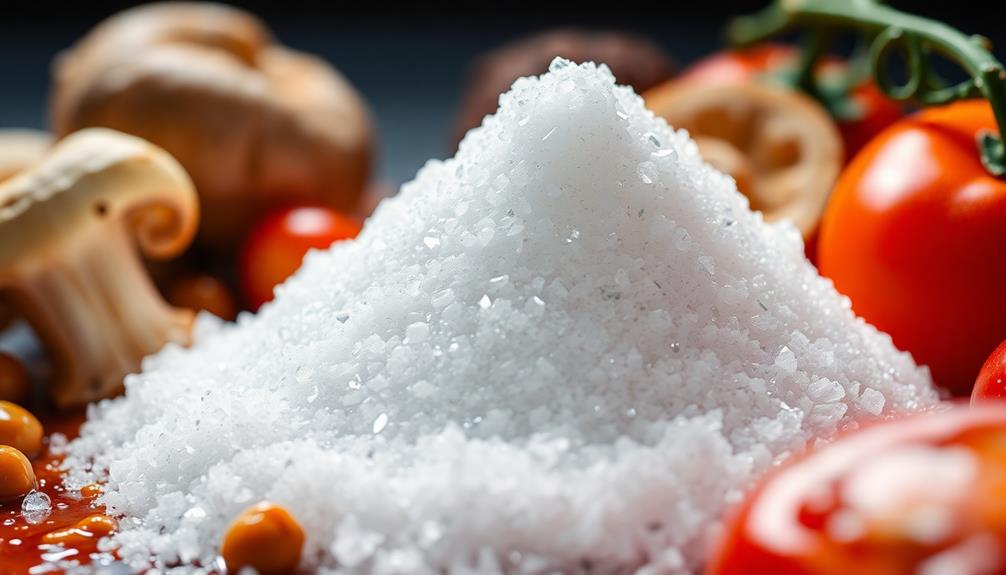
While many people enjoy the rich flavors of their favorite dishes, monosodium glutamate (MSG) serves as a powerful ally in enhancing those tastes. MSG is a sodium salt of glutamic acid, a compound that naturally occurs in many foods, including traditional ingredients like Umeboshi (Pickled Plum) that add a tart and savory note to dishes. By stimulating your glutamate receptors, MSG amplifies the umami flavor, making your meals more savory and satisfying.
Originally derived from seaweed, MSG is now primarily produced through the fermentation of starches and sugars, which makes it widely available and affordable. The FDA considers MSG safe for consumption, and despite some longstanding controversies, scientific studies have largely debunked claims of severe side effects. Most individuals can enjoy MSG without any adverse reactions.
One of the significant benefits of using monosodium glutamate (MSG) in your cooking is its ability to enhance umami flavor without increasing sodium content. This means you can create delicious dishes that are healthier and still packed with taste.
While a few people might report mild reactions, these instances are rare. So, when you're looking to elevate your culinary creations, consider adding MSG for that extra depth of flavor.
Health Perspectives on Umami
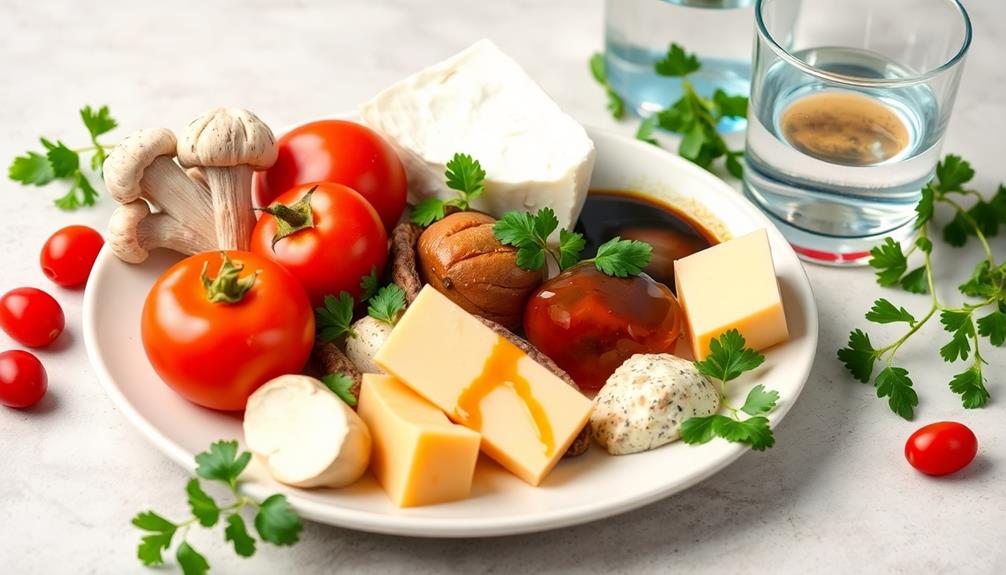
Umami's health benefits extend beyond just flavor enhancement. When you incorporate umami flavor into your meals, you're not just making them tastier; you're also boosting your health. For instance, using ingredients like mushrooms, which are rich in umami, can elevate dishes such as Nettle and Potato Soup, making them more satisfying and nutritious.
Here are three key benefits to reflect upon:
- Promotes Satiety: Foods rich in umami, like tomatoes and mushrooms, can make you feel fuller faster, which helps in managing weight without excessive calories.
- Reduces Sodium Intake: By using umami to enhance flavors, you can cut down on salt without sacrificing taste. This is particularly useful for those looking to lower their sodium consumption, as monosodium glutamate (MSG) can enhance the palatability of healthier dishes.
- Supports Appetite Stimulation: For seniors or those with reduced appetite, umami can stimulate hunger and increase salivation, making meals more enjoyable.
Incorporating ingredients like nutritional yeast can be an easy way to add umami flavor to your diet. The FDA deems MSG safe for consumption, so feel free to use it to enhance the taste of nutritious foods.
Embracing umami not only delights your palate but also supports a balanced and healthy lifestyle.
Frequently Asked Questions
What Is the Fifth Flavor Umami?
Umami is the fifth flavor that gives dishes a rich, savory taste. You'll find it in foods like aged cheeses, tomatoes, and mushrooms, enhancing the overall flavor and making your meals more satisfying and enjoyable.
Why Is Umami Controversial?
Umami's controversy feels like a culinary battlefield, where some swear it causes headaches while others praise its flavor-enhancing magic. You'll find cultural biases and misconceptions complicating its acceptance in Western cuisine.
What Is the Fifth Taste Quality Umami Described As?
The fifth taste quality, umami, is described as a pleasant, savory flavor that enhances dishes. When you taste it, you'll notice its richness, often found in foods like aged cheeses, mushrooms, and fermented products.
What Is an Example of Umami Taste?
When it comes to flavor, you've hit the jackpot with umami! Aged Parmesan cheese is a perfect example; its rich, savory taste can elevate any dish, adding depth that makes your taste buds dance with delight.
Conclusion
In the grand tapestry of flavors, umami adds a subtle richness that elevates your culinary experiences. It's not just a taste; it's a whisper of nature's bounty, inviting you to savor each bite more fully. As you explore umami, you're not just seasoning your meals; you're enhancing moments of connection and joy. So, the next time you reach for that savory ingredient, remember it's more than just flavor—it's a delightful embrace for your senses.




